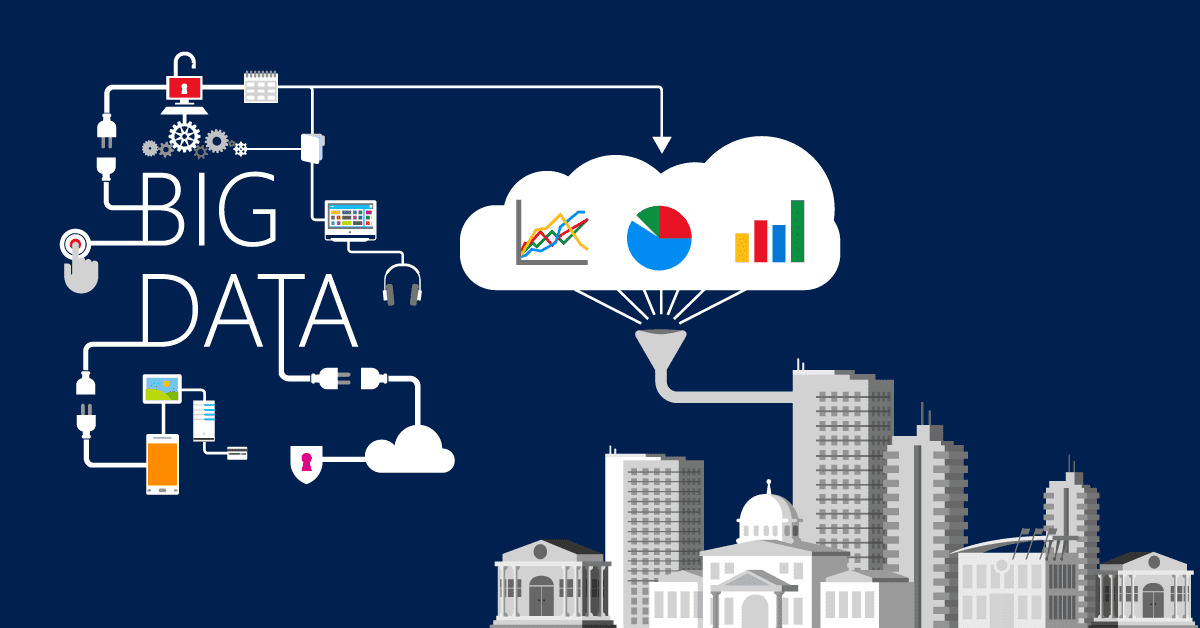Introduction
Welcome to the world of Big Data Policing, where cutting-edge technology and data analytics are transforming law enforcement practices. In recent years, the exponential growth of digital information and advanced algorithms has revolutionized the way police departments operate, enabling them to gather, analyze, and leverage massive amounts of data to enhance public safety and crime prevention.
Big Data Policing refers to the utilization of large volumes of data, encompassing various sources such as social media, surveillance systems, mobile devices, and criminal records, to inform and drive law enforcement strategies. By harnessing the power of data, police agencies aim to gain valuable insights, identify patterns, and predict criminal activities, ultimately leading to more effective policing.
The application of Big Data in policing is a relatively new concept; however, its potential impact has garnered significant attention from both law enforcement agencies and academic researchers. While this approach offers exciting possibilities for improving public safety, it also raises important questions about ethics, privacy, and the potential risks associated with the use of sensitive data in law enforcement practices.
Throughout this article, we will delve into the world of Big Data Policing, exploring its definition, historical context, benefits, challenges, and the ethical and privacy concerns it raises. We will also examine real-life examples of Big Data Policing initiatives and discuss the future implications of this emerging field.
Without further ado, let us embark on this journey to understand how Big Data is reshaping the landscape of law enforcement and shaping the way we approach crime prevention and public safety.
Definition of Big Data Policing
Big Data Policing can be defined as the use of advanced data analytics and technology to collect, process, and analyze large volumes of data in order to inform and guide law enforcement strategies and operations. This approach involves the integration of various data sources, including social media data, surveillance feeds, crime reports, and other relevant information, to extract meaningful insights and patterns that can assist in crime prevention, investigation, and public safety initiatives.
The key concept behind Big Data Policing is the idea that by analyzing vast amounts of data, law enforcement agencies can identify patterns, trends, and correlations that may not be apparent through traditional methods of investigation. By leveraging data analytics tools and technologies, police departments can make more informed decisions, allocate resources effectively, and stay one step ahead of potential threats.
One of the primary goals of Big Data Policing is to implement proactive strategies that prevent crimes from occurring in the first place. This is achieved by analyzing historical crime data and identifying hotspots, patterns, and trends that can inform targeted interventions and resource allocation. For example, by identifying areas with high rates of specific crimes, such as burglaries or drug trafficking, law enforcement agencies can deploy additional patrols or conduct targeted investigations to disrupt criminal activities.
In addition, Big Data Policing also encompasses the use of predictive analytics to forecast future crime incidents. By applying algorithms to historical crime data, police departments can generate predictions and insights into potential patterns or areas of concern, allowing them to allocate resources in a more efficient and effective manner. This proactive approach can significantly enhance public safety by deterring or preventing criminal activities before they occur.
It is important to note that Big Data Policing is not solely focused on crime prevention and intervention. It also plays a crucial role in post-incident analysis and investigation. By analyzing digital evidence, such as surveillance footage, social media posts, or electronic communications, law enforcement agencies can gather valuable insights that can aid in identifying suspects, reconstructing events, and building strong cases.
Overall, Big Data Policing represents a paradigm shift in law enforcement, leveraging the power of data and technology to enhance the effectiveness and efficiency of policing practices. By integrating advanced analytics, algorithms, and data-driven approaches, law enforcement agencies can tackle crime in a more proactive, targeted, and efficient manner.
History of Big Data Policing
The concept of using data for policing purposes is not entirely new. Law enforcement agencies have long relied on data to inform their strategies and improve their effectiveness. However, the advent of Big Data and advancements in technology have revolutionized the way data is collected, analyzed, and used in policing practices.
The origins of Big Data Policing can be traced back to the late 20th century when advancements in computing power and the proliferation of digital technology paved the way for more sophisticated data analysis. The emergence of databases and the digitization of criminal records enabled law enforcement agencies to store and access vast amounts of information more efficiently.
In the early years, the focus was primarily on using data for investigative purposes, such as maintaining criminal databases and cross-referencing information across jurisdictions. The integration of databases allowed law enforcement agencies to better track and apprehend criminals by sharing information and identifying patterns of criminal behavior.
As technology continued to evolve, so did the capabilities of data analysis in policing. In the late 1990s and early 2000s, the rise of internet usage led to the inclusion of online data sources in law enforcement investigations. This expanded the scope of available information for analysis, with law enforcement agencies leveraging social media platforms, online marketplaces, and other web-based resources to gather intelligence and identify potential threats.
The true turning point for Big Data Policing, however, came with the proliferation of surveillance systems and the increasing prevalence of digital devices in people’s lives. The exponential growth of CCTV cameras, body-worn cameras, and mobile phones has generated an enormous amount of data that can be harnessed for law enforcement purposes. By incorporating video analytics and data mining techniques, law enforcement agencies can extract valuable insights from surveillance footage and identify individuals or vehicles of interest.
Simultaneously, the rise of predictive analytics has had a profound impact on policing strategies. As computing power and algorithms advanced, law enforcement agencies began to explore the predictive capabilities of data analysis. By analyzing historical crime data and other relevant variables, such as weather patterns or demographics, predictive analytics can forecast future crime hotspots and assist in resource allocation and proactive policing efforts.
Today, Big Data Policing continues to evolve as technology advances and the availability of data grows exponentially. With the advent of artificial intelligence and machine learning, law enforcement agencies are exploring new possibilities, such as real-time analysis of social media data to detect and respond to potential threats.
With each passing year, data becomes an increasingly critical component of modern policing. Law enforcement agencies are continually adapting their practices, embracing Big Data Policing to enhance their capabilities, improve public safety, and stay ahead of evolving criminal activities.
Benefits of Big Data Policing
The adoption of Big Data Policing offers numerous benefits that can greatly enhance law enforcement efforts and promote public safety. Here are some key advantages of utilizing big data in policing practices:
- Crime Prevention: Big Data Policing enables law enforcement agencies to proactively prevent crimes by identifying patterns, trends, and hotspots. By analyzing historical crime data and other relevant variables, predictive analytics can help allocate resources effectively and target interventions for maximum impact.
- Efficient Resource Allocation: Using big data analytics, law enforcement agencies can allocate resources more efficiently. By identifying areas or timeframes with higher crime rates, police departments can strategically deploy personnel and assets, resulting in optimized resource utilization.
- Improved Investigations: Big Data Policing helps enhance the investigative process. By leveraging data from various sources, such as surveillance footage, social media posts, or electronic records, law enforcement agencies can identify suspects, reconstruct timelines, and generate leads to solve crimes more quickly and effectively.
- Identifying Emerging Trends: Big Data Policing allows for the timely identification of emerging crime trends. By analyzing real-time data, law enforcement agencies can detect shifts in criminal activity, such as emerging drug markets or new modus operandi, and respond proactively to mitigate potential threats.
- Enhanced Officer Safety: By leveraging big data analytics, law enforcement agencies can gain valuable insights to enhance officer safety. Real-time analysis of data, such as sensor readings or officer location information, can alert officers to potential risks and provide situational awareness to minimize danger.
- Community Engagement: Big Data Policing can foster community engagement and collaboration. By leveraging social media and other online platforms, law enforcement agencies can gather information and communicate with the community, improving trust, and building positive relationships.
- Intelligence-Led Policing: Big Data Policing supports intelligence-led policing practices. By integrating and analyzing data from various sources, law enforcement agencies can create comprehensive intelligence profiles on individuals or groups involved in criminal activities, facilitating targeted enforcement efforts.
- Proactive Approach: Big Data Policing enables a proactive approach to law enforcement. By leveraging data-driven insights and predictive analysis, agencies can identify potential threats, intervene before crimes occur, and disrupt criminal networks and activities.
- Evidence Collection and Management: Big Data analytics assists in evidence collection and management. By digitizing and analyzing vast amounts of data, law enforcement agencies can streamline the evidence gathering process, ensuring accurate and comprehensive information is presented for prosecution.
These benefits highlight the transformative impact that Big Data Policing can have on law enforcement practices. By harnessing the power of data analytics and technological advancements, law enforcement agencies can become more efficient, effective, and proactive in their efforts to maintain public safety.
Challenges of Big Data Policing
While Big Data Policing offers significant benefits, its adoption also comes with various challenges and considerations that law enforcement agencies must address. Here are some of the key challenges associated with Big Data Policing:
- Data Quality and Accuracy: Ensuring the quality and accuracy of data is crucial for effective analysis. Law enforcement agencies must have mechanisms in place to verify the reliability of data sources, address data gaps or inconsistencies, and mitigate the risk of biased or flawed data affecting decision-making.
- Data Privacy and Protection: The use of big data in policing raises important privacy concerns. Law enforcement agencies must navigate the complexities of data privacy laws and regulations, ensuring proper measures are in place to protect the privacy and rights of individuals whose data is collected and analyzed.
- Ethical Considerations: Big Data Policing poses ethical dilemmas that need careful consideration. The use of data analytics and predictive algorithms may lead to potential biases or profiling of certain populations. Law enforcement agencies must adopt ethical frameworks and guidelines to ensure fairness, transparency, and accountability in their data-driven practices.
- Technological Limitations: Implementing Big Data Policing requires robust technological infrastructure and expertise. Law enforcement agencies must invest in the necessary systems, tools, and training to handle large amounts of data, as well as protect against cyber threats and ensure data integrity.
- Integration of Data Sources: Big Data Policing involves the integration of data from numerous sources, which can be challenging. Law enforcement agencies should establish data-sharing agreements, develop standardized protocols, and implement interoperable systems to enable seamless and secure data integration.
- Legal and Regulatory Frameworks: The use of big data in policing raises legal and regulatory considerations. Law enforcement agencies must adhere to existing laws, such as the Fourth Amendment in the United States, and ensure compliance with relevant regulations and constitutional safeguards while leveraging data for investigative purposes.
- Public Perception and Trust: The adoption of Big Data Policing can be met with skepticism or concerns from the public. Law enforcement agencies must engage in transparent communication, educate the public about the benefits and limitations of data-driven policing, and actively address any misconceptions or fears surrounding the use of big data in law enforcement practices.
- Algorithmic Fairness and Bias: The algorithms used in data analytics and predictive modeling may inadvertently introduce bias. Law enforcement agencies must employ rigorous testing and validation processes to identify and mitigate algorithmic bias, ensuring fairness and avoiding discriminatory practices.
- Data Retention and Deletion: Law enforcement agencies must establish clear policies and procedures for data retention and deletion to comply with privacy regulations. The appropriate handling and disposal of data are essential to protect the privacy and secure the personal information of individuals.
Addressing these challenges requires a holistic approach, involving collaboration between law enforcement agencies, policymakers, technology providers, and privacy advocates. By addressing these challenges head-on, law enforcement agencies can harness the power of big data while upholding privacy, ethics, and accountability in their policing practices.
Examples of Big Data Policing Initiatives
Across the globe, law enforcement agencies have implemented various Big Data Policing initiatives to leverage the power of data analytics in their crime prevention and investigation efforts. Here are a few notable examples:
- Predictive Policing: In many cities, law enforcement agencies are utilizing predictive analytics to identify high-risk areas and allocate resources strategically. For example, the Los Angeles Police Department (LAPD) implemented the PredPol system, which uses historical crime data to generate real-time predictions of where and when crimes are likely to occur. The system helps officers patrol and respond to potential incidents more efficiently.
- Social Media Monitoring: Law enforcement agencies are increasingly tapping into social media platforms to gather intelligence and detect potential threats. For instance, the New York Police Department (NYPD) created the Domain Awareness System (DAS), which combines data from surveillance cameras, license plate readers, and social media feeds to monitor and analyze activities in real-time, aiding in crime prevention and investigations.
- Gang Intelligence Databases: Gang-related crimes and activities pose significant challenges for law enforcement agencies. Big Data Policing has facilitated the development of comprehensive gang intelligence databases that aggregate information on known gang members, their affiliations, criminal activities, and social connections. This data assists agencies in identifying gang networks and taking targeted enforcement actions.
- Real-Time Video Analytics: With the proliferation of video surveillance systems, law enforcement agencies are employing real-time video analytics to monitor for suspicious activities and identify potential threats. For instance, the Chicago Police Department uses video analytics software to automatically detect gunshots and promptly dispatch officers to the location, enhancing response times and crime prevention efforts.
- Emergency Response Optimization: Big Data Policing aids in optimizing emergency responses. For example, the London Metropolitan Police uses historical crime data, combined with real-time incident reports and traffic information, to dynamically deploy resources during major events or emergencies. This data-driven approach enables more efficient resource allocation and quicker response times.
- Intelligence-Led Investigations: Big Data Policing assists in intelligence-led investigations by consolidating data from various sources into a single platform. Law enforcement agencies can analyze phone records, financial transactions, and social media profiles to link individuals or groups to criminal activities. The Integrated Ballistic Identification System (IBIS) is an example of such a system that helps trace firearms used in crimes based on ballistics data.
- Smart Policing: Smart policing initiatives leverage data analytics and technology to address specific types of crimes or recurring issues. For instance, the Operation Ceasefire program implemented in multiple cities uses data analysis to identify individuals at high risk of involvement in gun violence and provides them with targeted interventions, support, and resources to steer them away from criminal activities.
- Collaborative Data-Sharing Platforms: Law enforcement agencies are increasingly adopting collaborative data-sharing platforms to facilitate real-time information exchange and coordination. This enables multiple agencies to pool their data and resources, enhancing their collective ability to detect and respond to criminal activities effectively.
These examples highlight how law enforcement agencies are harnessing big data and advanced analytics to improve crime prevention, investigation, and overall public safety. By leveraging the power of data, these initiatives help agencies make informed decisions, allocate resources efficiently, and stay one step ahead of potential threats.
Ethical Considerations in Big Data Policing
The implementation of Big Data Policing raises important ethical considerations that must be carefully addressed to ensure the responsible and fair use of data in law enforcement practices. Here are some key ethical considerations in Big Data Policing:
- Privacy Protection: One of the primary ethical concerns is the protection of individual privacy. Law enforcement agencies must strike a balance between utilizing data for crime prevention and investigation while respecting the privacy rights of individuals. Strict safeguards should be in place to prevent the misuse or unauthorized access to sensitive personal information.
- Data Accuracy and Quality: Big Data Policing relies on accurate and high-quality data for reliable analysis. Law enforcement agencies must ensure the integrity and accuracy of data sources to avoid biases, false positives, or other errors that could lead to unjust outcomes.
- Transparency and Explainability: Law enforcement agencies must be transparent about the data-driven methods they employ and be able to explain the rationale behind their decisions. The transparency of algorithms and data processing techniques enhances public trust and allows for scrutiny and accountability.
- Fairness and Avoiding Bias: Big Data Policing algorithms must be designed and implemented with a focus on fairness and the avoidance of biases. Care should be taken to mitigate algorithmic biases that may disproportionately target specific communities or populations, ensuring that law enforcement practices do not result in discriminatory outcomes.
- Consent and Informed Decision-Making: Ideally, individuals should be provided with clear, understandable information about the collection, storage, and use of their data by law enforcement agencies. Obtaining informed consent whenever possible can help build trust and ensure that individuals are aware of how their data is being utilized.
- Accountability and Oversight: Law enforcement agencies should have mechanisms in place to ensure accountability for the use of data in policing. There should be systems for reviewing and auditing data-driven decisions and practices to guarantee they align with legal and ethical standards.
- Proportional and Necessity Principle: Big Data Policing initiatives should abide by the principle of proportionality and necessity. Data collection and analysis should be limited to what is necessary and proportional for the stated law enforcement purpose, minimizing the intrusion on individuals’ privacy.
- Data Security and Protection: Safeguarding the security and protection of data is crucial to maintain public trust. Law enforcement agencies must implement robust security measures to prevent unauthorized access, data breaches, and other potential risks to individuals’ sensitive information.
- Long-Term Data Retention: Law enforcement agencies must establish clear policies for the retention and disposal of data to ensure compliance with privacy regulations. Periodic data audits and regular purging of unnecessary data help minimize the risks associated with long-term data storage.
Addressing these ethical considerations requires multidisciplinary collaboration between law enforcement agencies, policymakers, legal experts, and privacy advocates. By incorporating ethical frameworks and guidelines into Big Data Policing practices, law enforcement agencies can ensure responsible and accountable use of data while upholding the rights and privacy of individuals involved.
Privacy Concerns in Big Data Policing
The use of big data in policing practices has raised significant privacy concerns due to the vast amount of personal data collected and analyzed. Here are some key privacy concerns in Big Data Policing:
- Mass Surveillance: One of the primary concerns is the potential for mass surveillance. The extensive collection of data from various sources, such as surveillance cameras, social media platforms, and mobile devices, raises concerns about the intrusion on individuals’ privacy and the erosion of civil liberties.
- Scope Creep: Privacy concerns arise when the purpose of data collection extends beyond the original intent. Law enforcement agencies must ensure that the data collected is relevant and necessary for the specific law enforcement purposes, preventing the misuse of data for unrelated activities or unauthorized surveillance.
- Data Security: The large-scale collection and storage of sensitive data increase the risk of data breaches and unauthorized access. Law enforcement agencies must implement robust security measures to protect personal information and prevent it from falling into the wrong hands.
- Technological Vulnerabilities: Big Data Policing relies heavily on technological infrastructure and data processing systems. However, vulnerabilities in these technologies, such as hacking or abuse by insiders, pose a significant risk to the privacy of individuals whose data is being collected and analyzed.
- Data Sharing: The sharing of data between different agencies or entities raises concerns about the potential for misuse, unauthorized access, or secondary uses of the data. It is crucial for law enforcement agencies to establish clear protocols and data sharing agreements to ensure transparency, accountability, and compliance with privacy regulations.
- De-identification and Re-identification: Anonymizing data is often used as a privacy protection measure. However, there is a risk of re-identification, where supposedly anonymized data can be linked back to specific individuals. Law enforcement agencies must employ adequate measures to protect against re-identification and uphold the privacy rights of individuals involved.
- Proportional Data Collection: The principle of proportionality dictates that data collection should be limited to what is necessary and proportional to the stated law enforcement purpose. Excessive or indiscriminate data collection can pose a threat to individuals’ privacy and should be avoided to minimize privacy risks.
- Lack of Consent: Privacy concerns arise when individuals’ data is collected and processed without their informed consent. While there may be legal exceptions for certain law enforcement activities, efforts should be made to inform individuals about the collection and use of their data, enabling them to make informed decisions and exercise control over their personal information.
- Long-Term Data Retention: Retention of data beyond what is necessary raises concerns about the potential for misuse and the risk of unauthorized access. Law enforcement agencies must establish clear policies for the timely disposal of data to minimize the privacy impact and comply with privacy regulations.
Addressing these privacy concerns requires a careful balance between the legitimate goals of law enforcement and the protection of citizens’ privacy rights. Law enforcement agencies must adopt privacy-centric practices, conduct privacy impact assessments, and implement appropriate measures to safeguard personal data throughout the data lifecycle.
Future of Big Data Policing
The future of Big Data Policing holds great potential for innovation and advancement in law enforcement practices. Here are some key aspects that will shape the future of Big Data Policing:
- Advanced Analytics and Artificial Intelligence: As technology continues to evolve, law enforcement agencies will leverage more sophisticated analytics and artificial intelligence capabilities. Machine learning algorithms can analyze vast amounts of data to identify complex patterns, detect anomalies, and generate predictive insights, enabling more precise crime prevention and investigation techniques.
- Internet of Things (IoT) Integration: The integration of IoT devices, such as smart sensors, wearable devices, and connected surveillance systems, will provide law enforcement agencies with real-time data streams for enhanced situational awareness. This will enable quicker response times, proactive policing efforts, and more accurate risk assessments.
- Geospatial Analysis: Geospatial analysis, combined with data visualization techniques, will play a significant role in future Big Data Policing. By overlaying crime data with geographic information, law enforcement agencies can identify hotspots, trends, and patterns more effectively, allowing for targeted interventions and optimized resource allocation.
- Social Media Intelligence: Social media platforms continue to generate enormous amounts of data. Law enforcement agencies will increasingly harness social media analytics to gather intelligence, detect emerging threats, and identify potential criminal activities. Natural language processing and sentiment analysis can help sift through vast social media conversations to extract relevant information and insights.
- Collaborative Data Analytics: Law enforcement agencies will leverage collaborative data analytics platforms to share and analyze data with other agencies, creating a more holistic and comprehensive understanding of criminal activities. Interagency collaboration will become more prevalent, enabling information exchange and coordinated efforts to combat cross-jurisdictional crimes.
- Ethics and Accountability: With the increasing use of big data in policing, the ethical and accountable use of data will become paramount. Law enforcement agencies will establish clear guidelines and frameworks to ensure privacy, fairness, transparency, and accountability in their data-driven practices. Continuous monitoring and external oversight will play a crucial role in upholding these principles.
- Data Governance and Privacy Regulations: As the use of personal data in law enforcement expands, more robust data governance frameworks and privacy regulations will be developed and enforced. These regulations will aim to strike a balance between the use of data for crime prevention and investigation and safeguarding individuals’ privacy rights, ensuring data protection, consent, and data minimization principles in Big Data Policing initiatives.
- Real-Time Predictive Policing: The future of Big Data Policing will see a shift towards real-time predictive policing. Advanced algorithms and integration with various data sources will enable law enforcement agencies to generate up-to-date predictions of crime hotspots, anticipate emerging threats, and allocate resources dynamically, leading to more proactive and effective policing strategies.
- Public Engagement and Trust Building: Law enforcement agencies will place a greater emphasis on public engagement and trust building. Transparent communication about the use of data, privacy safeguards, and benefits of Big Data Policing initiatives will help build confidence among communities, ensuring that data-driven practices are conducted in a manner that aligns with the needs and expectations of the public.
The future of Big Data Policing holds immense potential for transformative advancements in crime prevention and investigation. By leveraging emerging technologies, adopting ethical frameworks, and ensuring privacy safeguards, law enforcement agencies can navigate the opportunities and challenges of Big Data Policing, fostering safer and more secure communities in the years to come.
Conclusion
The emergence of Big Data Policing has transformed the landscape of law enforcement, revolutionizing the way data is collected, analyzed, and utilized to enhance public safety and combat crime. From predictive analytics and real-time monitoring to social media intelligence and collaborative data-sharing initiatives, law enforcement agencies are leveraging advanced technology and data analytics to make more informed decisions, allocate resources effectively, and tackle crime proactively.
While the benefits of Big Data Policing are evident, it is crucial to address the ethical considerations and privacy concerns associated with the use of personal data in law enforcement practices. Privacy protection, data accuracy, fairness, transparency, and accountability should be at the forefront of the development and implementation of Big Data Policing initiatives. Striking the right balance between effective crime prevention and investigation and the protection of individuals’ privacy rights is essential to maintain public trust and legitimacy.
The future of Big Data Policing holds great promise. Advancements in artificial intelligence, IoT integration, geospatial analysis, and collaborative data analytics will further enhance the capabilities of law enforcement agencies. However, it is imperative that these advancements go hand in hand with strong data governance, privacy regulations, and public engagement. Law enforcement agencies must continue to prioritize ethical guidelines, establish clear policies, and engage in transparent communication to ensure responsible and accountable use of data in their policing practices.
As technological advancements continue to shape the world, Big Data Policing will continue to evolve, providing law enforcement agencies with powerful tools to address emerging challenges and keep our communities safe. Through responsible data collection, analysis, and use, law enforcement agencies can leverage the power of big data to transform the way they prevent and respond to crime, ensuring a safer and more secure society for all.
























